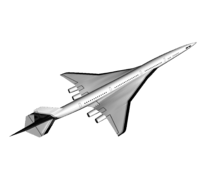High Speed Civil Transport
| High Speed Civil Transport | |
|---|---|
.jpg) | |
| Project for | Supersonic transport |
| Issued by | NASA |
| Outcome | Study only |

The High Speed Civil Transport (HSCT), a supersonic airliner, was the focus of the High-Speed Research (HSR) Program, a NASA program to develop the technology needed to design and build a supersonic transport that would be environmentally acceptable and economically feasible. The aircraft was to be a future supersonic passenger aircraft, baselined to cruise at Mach 2.4,[1] or more than twice the speed of sound. The project started in 1990 and ended during 1999. The goal was to employ up-to-date technologies.
It was intended to cross the Atlantic or the Pacific Ocean in half the time of a non-supersonic aircraft. It was also intended to be fuel efficient, carry 300 passengers, and to allow customers to buy tickets at a price only slightly higher than those of subsonic aircraft. The goal was to provide sufficient technology for an industry-led product launch decision in 2002, and if a product was launched, a maiden flight within 20 years.
The program was based on the successes and failures of the British/French Concorde and the Russian Tupolev Tu-144, as well as a previous NASA Supersonic Transport (SST) program from the early 1970s (for the latter, see Lockheed L-2000 and Boeing 2707.) While the Concorde and Tu-144 programs both produced production aircraft, neither was produced in sufficient numbers to pay for their development costs.
References
- ↑ "High-Speed Civil Transport Study: Summary". NASA CR-4234. Boeing Commercial Airplanes. 1989. Retrieved 2013-04-29.
External links
- Allen, Robert ‘Bob’ (April 22, 2008). "NASA's High-Speed Research (HSR) Program – Developing Tomorrow's Supersonic Passenger Jet". NASA. Retrieved 21 May 2011.
- Shaw (2000) [1998], GRC (overview of project), NASA.
- http://oea.larc.nasa.gov/PAIS/HSR-Overview2.html (overview), NASA External link in
|title=(help).